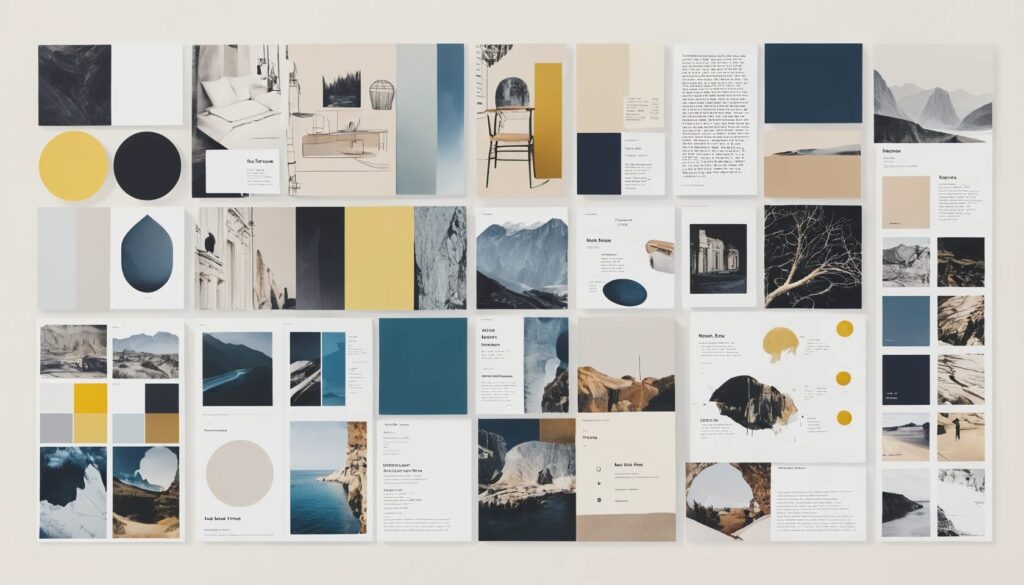Unlocking Creativity: The Power of Mood Boards
Ever stared at your screen, waiting for inspiration to strike like some divine creative intervention? Spoiler alert: it rarely happens. Creative blocks are real, and they can turn even the most brilliant minds into blank slates. But fear not—mood board creation exists to rescue you from the abyss of design paralysis.
Whether you’re designing a brand identity, planning a wedding, or mapping out the perfect aesthetic for your new apartment, a well-structured mood board can transform abstract ideas into tangible vision. And thanks to digital visual design tools like Canva, creating a stunning mood board is no longer reserved for professional designers.
Why Every Creative Needs a Mood Board
- Provides a Clear Visual Direction – No more second-guessing design choices.
- Boosts Collaboration – Helps teams align creatively before executing ideas.
- Sparks Creativity – A well-curated board can lead to innovative solutions.
- Prevents Costly Revisions – Establishing a strong foundation minimizes design missteps.
Think of a mood board as your creative GPS. Instead of aimlessly wandering through a labyrinth of mismatched fonts and clashing color palettes, you get a clear roadmap guiding your aesthetic choices. And the best part? Mood boards aren’t rigid—they can be as structured or chaotic as you need them to be.
How to Create a Mood Board Like a Pro
- Define Your Purpose – Establish the goal before compiling elements.
- Gather Visual Inspiration – Collect images, textures, and color schemes that align with your vision.
- Use Ready-Made Mood Board Templates – Platforms like Canva offer pre-designed templates.
- Organize Thoughtfully – Arrange elements strategically for maximum impact.
- Refine and Edit – Remove anything that doesn’t contribute to the overall aesthetic.
Starting from scratch can be overwhelming, but using pre-made mood board templates can save you hours of frustration. These templates provide a structured foundation, allowing you to focus on curating elements rather than formatting.
Digital vs. Physical Mood Boards: Which One Wins?
- Digital Mood Boards – Easily editable, shareable, and accessible from anywhere.
- Physical Mood Boards – More tactile and immersive, ideal for hands-on creative processes.
- The Hybrid Approach – Combines digital convenience with physical tangibility.
Digital mood boards—especially with tools like Canva’s mood board creator—offer unmatched flexibility. But let’s be honest, sometimes there’s nothing more satisfying than cutting out magazine clippings and pinning them to a corkboard. If you thrive on hands-on creativity, the hybrid approach might be your sweet spot.
Common Mood Board Mistakes (And How to Avoid Them)
- Overloading with Too Many Elements – Clutter weakens your vision.
- Ignoring Consistency – Every element should align with the intended aesthetic.
- Being Too Literal – Abstract inspiration often leads to more unique designs.
- Skipping Refinement – A mood board should evolve before finalizing.
Throwing random visuals together doesn’t make a mood board—it makes a mess. Be selective, ensure consistency, and refine your board until it effectively communicates your desired look and feel.
Bringing Your Mood Board to Life
- Use It as a Reference – Let it guide your design choices throughout the project.
- Share It with Stakeholders – Keep everyone aligned before execution.
- Update It as Needed – Creativity evolves, and your mood board should too.
A mood board isn’t just a pretty collage—it’s a tool. Make it a living document that evolves with your project, ensuring your final design stays true to your original vision.
Start Creating Your Mood Board Today
Still skeptical? Try it yourself. Whether you’re designing a logo, redecorating your home, or planning an event, mood boards bring clarity to creative chaos. Plus, with tools like Canva, even non-designers can create something visually stunning.
So go ahead, channel your inner creative genius, and start mood boarding your way to brilliance.
